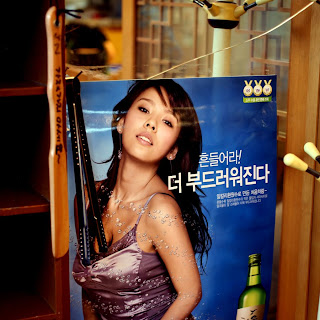
Sunday is a different kind of day at the fish market. Slow, sulky, half-closed... like waking up from a long afternoon nap. Saturday's throbbing and icy metropolis has cleared out and left behind a shell of its former self. While both days have their charms, the chance of a bruising collision with an oncoming ice truck is far less likely on Sunday.
In fact, the flow of the Sunday morning fish market is gentle enough that the fishmongers notice your footwear. Having learned a shoe lesson on my first visit, this time I wore my rubber rain boots which happen to be covered in small fish silhouettes. As we passed the vendors they'd point at my boots. Point, smile, laugh...
Once I figured out what was going on I'd point at my boots and give them a thumbs-up, and and they seemed pretty happy with that. My theory is that the fishmongers had a certain appreciation for fish market boots with pictures of fish on them. Either that or they'd never seen women's feet that large before.

I hadn't realized it the first time I went to the first market, but there's actually a second floor and in addition to being a great vantage point from which to see all the fish market action, it's also a really good place to eat. The second floor walkway is lined with restaurants whose front doors look out on the market below and what these places lack in high-end atmosphere, they make up for with fresh fish. And then some.
Choosing a restaurant was easy - we went to the only one we could find that was open before noon. We took off our shoes (and rubber boots) and found a seat on the floor. I was happy to see that they had one of my favorite dishes on the menu; hoedeopbap is basically bibimbap with raw fish. So you get a bowl of rice with fresh vegetables, herbs, seaweed, sesame seeds and spicy sauce, topped with slices of raw fish. It's one of the lightest and freshest dishes you can eat in Korea and if it weren't for a certain someone's not very secret concerns about mercury poisoning, I'd be eating a lot more of it.

This restaurant's version was the best I've had so far in Seoul and the side dishes were good enough to be promoted to main dish stature. I'm used to seeing a small fried fish come out with my meal but I'm still not used to eating it. I sort of pick around with my chopsticks hoping that a hunk of delicious fish will volunteer to part ways with the substantial skeleton still inside it. Sometimes it works and sometimes I find myself looking for discreet ways to remove fish bones from my mouth.

Once the Hoedeopbap was no more, and bones were all that was left of the fish, we unfolded our bodies from their awkward positions on the floor and headed to the front door to put our shoes back on. I hadn't noticed it on the way in but hanging by the shoe shelf was a long-handled shoe horn. A nice touch. But even better, the shoe horn - along with a pair of random metal tongs - was hanging next to the omnipresent soju girl poster. Soju is a popular Korean alcoholic drink and if you haven't seen this poster, you don't live in Korea. (I fear she may be more popular than the president.)

While I was taking this photo the owner of the restaurant quickly scurried over and took away the shoe horn and tongs, presumably to give me a better shot of everybody's favorite soju girl. I didn't have the heart to tell her that I wanted a picture of the shoe horn too. Ok, not so much that I didn't have the heart to tell her, but rather that I don't know how to say "I like the shoe horn so you don't have to move it." So instead I said one of the words I
do know in Korean - thank you - and took a few more photos of the poster without the shoe horn too.
Sometimes I worry that my lack of Korean language is keeping me from engaging with Koreans. But then I find myself laughing with fishmongers who like my rain boots, and smiling with restaurant owners over soju posters and shoe horns. I realize this is far from the height of international communication, but it'll have to do for now. At least until I learn the word for shoe horn.
















